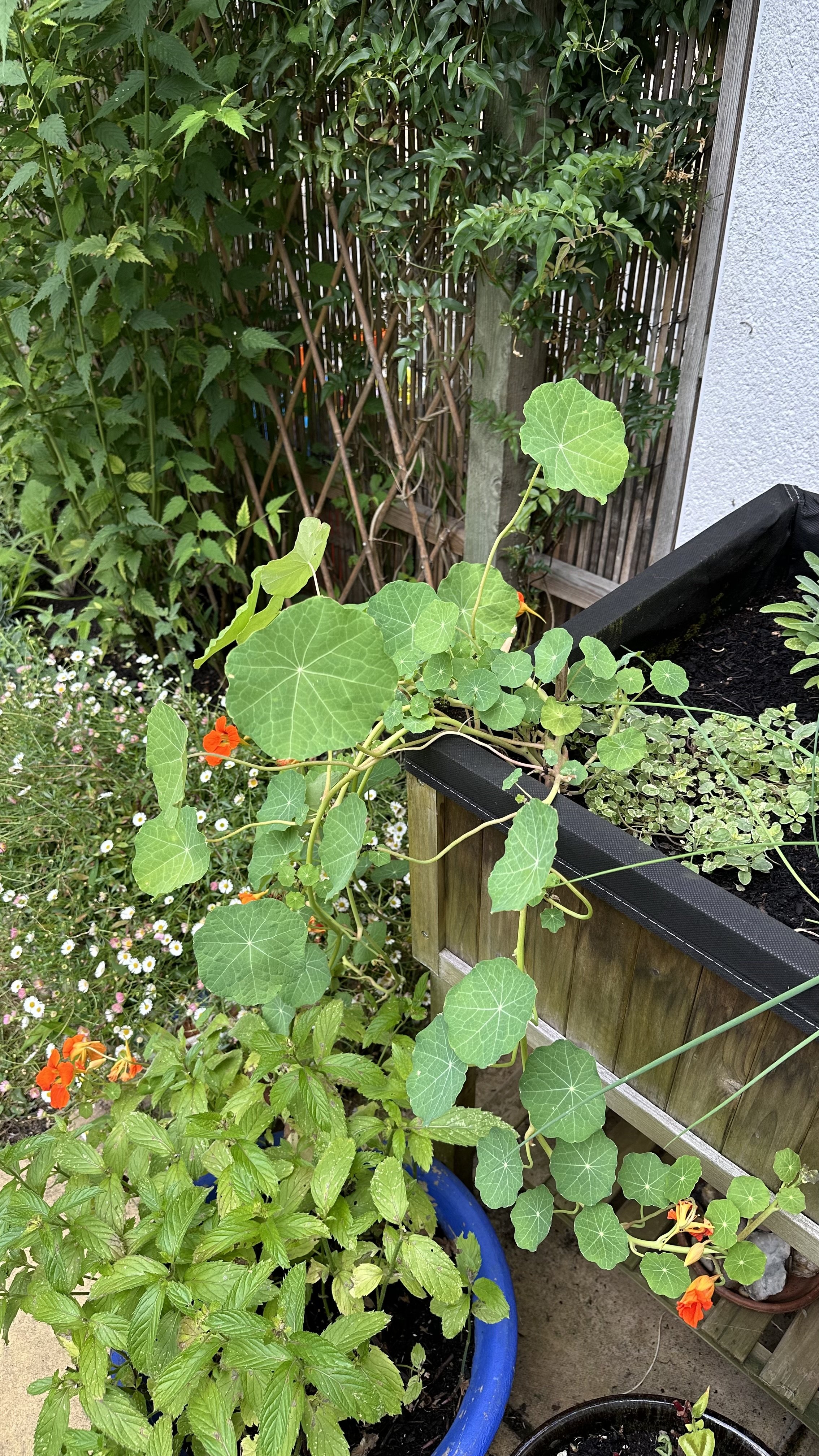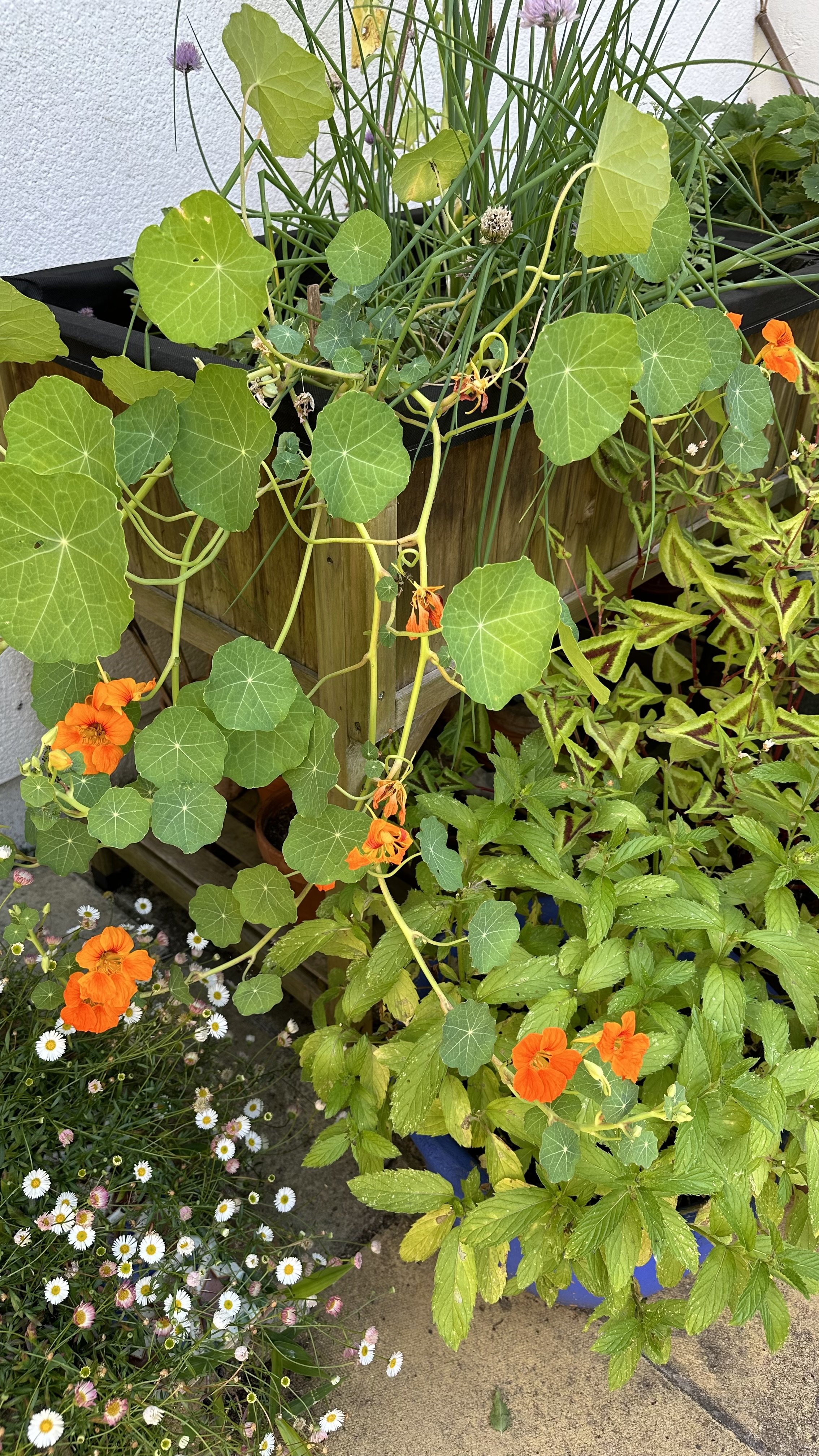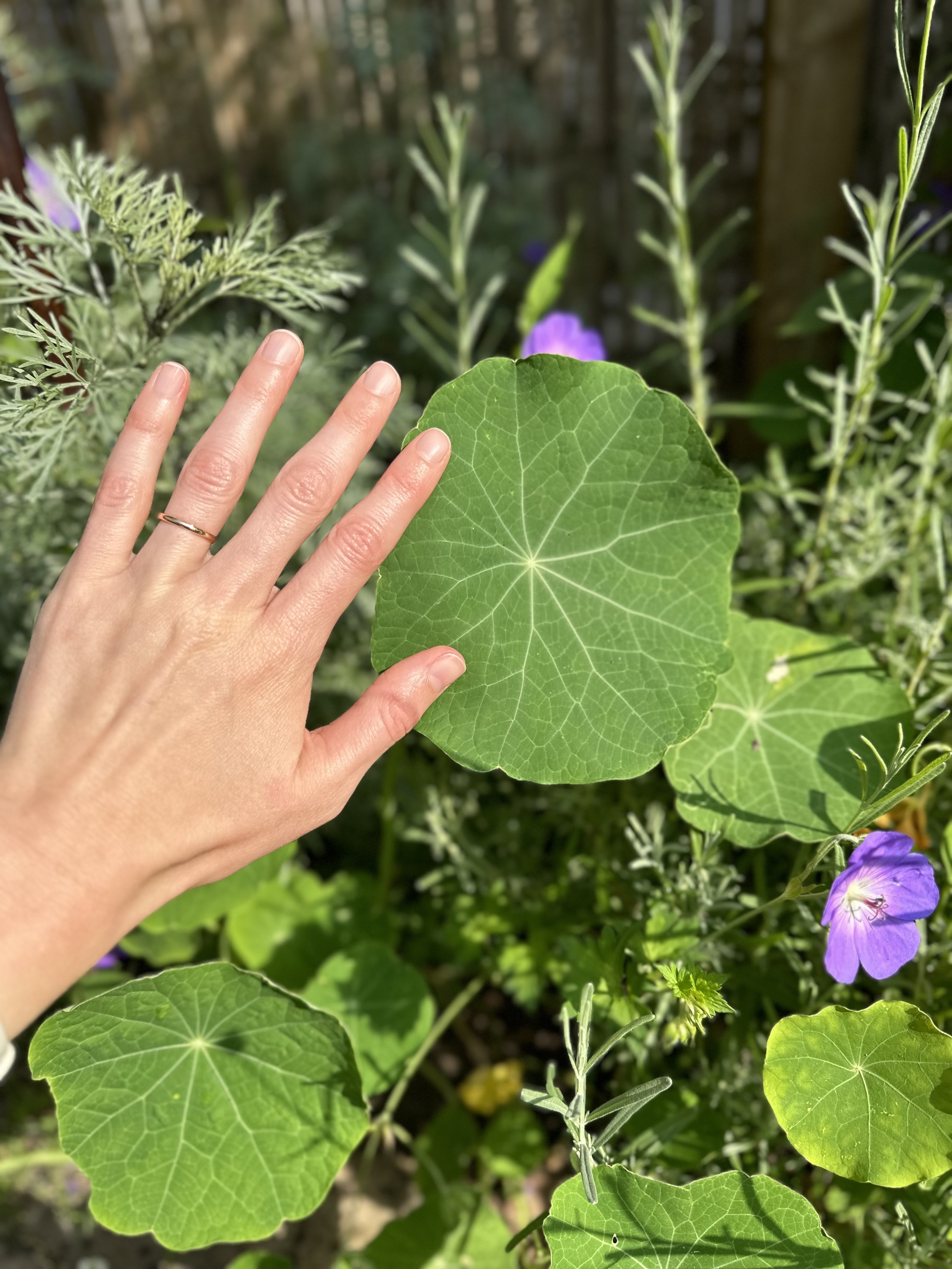Growing Nasturtium Flowers: From Seed to Bloom
This website is reader-supported - thank you! This post may contain affiliate links. As an Amazon Associate, I earn from qualifying purchases at no extra cost to you.
Nasturtium flowers are an easy, colorful addition to any garden, and they bring a lot more than just good looks.
I’ve grown them in various spots over the years, and they’ve become a go-to for their vibrant blooms, edible leaves, and ability to attract beneficial insects like bees and butterflies.
In this guide, I’ll share everything you need to know to grow nasturtium flowers successfully, whether you’re planting them in garden beds or pots.
To learn more about growing nasturtiums, check out my guides:
Utilizing Nasturtium Companion Plants for Natural Pest Control
Types of Nasturtium
Nasturtiums come in a variety of forms, each bringing unique colors and growth habits to your garden.
Whether you’re looking for vibrant trailing varieties or compact bushy plants, there’s a nasturtium type to fit your space and style.
1. Trailing Nasturtium (Vining Types)
Trailing nasturtiums are perfect for adding a cascading effect to pots, hanging baskets, or garden borders.
These types can grow several feet long, making them great for climbing trellises or spilling over the edges of containers.
They create a stunning display of foliage and flowers, making a big impact even in small spaces.
2. Bush Nasturtium (Dwarf Types)
If you have limited space, bush or dwarf nasturtiums are a fantastic choice.
These compact plants form a rounded shape and stay lower to the ground, typically growing about 12-18 inches tall.
They’re perfect for borders, small garden beds, or container planting when you want a neat, tidy look.
3. Climbing Nasturtium
Climbing nasturtiums are vigorous growers that love to scramble up fences, trellises, or arbors.
They can reach impressive heights and are ideal for adding vertical interest to your garden.
Give them something to climb on, and watch them take off!
4. Popular Varieties
‘Black Velvet’:
This variety features striking, almost black blooms that add a dramatic touch to any garden.
It’s a standout among nasturtium varieties for its deep, rich color.
Here are the seeds I recommend:
‘Peach Melba’:
With its creamy yellow petals and a splash of red at the center, ‘Peach Melba’ is a favorite for its soft, romantic look.
It’s a lovely choice for adding delicate color to garden beds or pots.
Here are the seeds I recommend:
‘Jewel Blend’:
This mix offers a range of vibrant colors, including red, orange, and yellow flowers.
It’s a great way to get a variety of blooms from a single packet of seeds.
Here are the seeds I recommend:
‘Alaska’:
Known for its unique variegated foliage, ‘Alaska’ features green and white marbled leaves with bright, cheerful flowers.
It’s a fun choice if you want something a little different.
Here are the seeds I recommend:
5. Tropaeolum majus (Common Nasturtium)
The most popular and widely grown nasturtium species, Tropaeolum majus, is beloved for its large, showy flowers and easygoing nature.
This species includes many of the well-known varieties like ‘Black Velvet’ and ‘Jewel Mix.’
It’s a versatile plant that works well in both garden beds and containers.
Choosing the Right Type for Your Garden
When selecting a nasturtium variety, consider the space you have available and the look you want to achieve.
Trailing and climbing types are perfect for adding height and drama, while bush types are great for filling in borders or smaller areas.
With so many beautiful options, you’re sure to find a nasturtium that fits your gardening style perfectly.
Nasturtiums are a great addition to a vegetable garden.
Read more in my guide:
How to Plant Nasturtiums
Planting nasturtiums has become one of my favorite gardening activities.
Picking the Right Seeds
The first step is choosing your nasturtium seeds.
There are so many wonderful varieties out there.
Personally, I've enjoyed planting seeds that produce bright yellow flowers, fiery orange flowers, and deep red flowers.
If you're looking for something unique, varieties like 'Black Velvet' offer a deep, rich hue, while trailing nasturtiums can add a lovely cascading effect to your garden beds or containers.
Finding the Perfect Spot
Nasturtiums thrive in full sun, but they can tolerate a bit of partial shade if needed.
In my own garden, I've found that they do best in spots that receive plenty of sunlight throughout the day.
They're not too picky about soil quality, which is great news for those of us with less-than-perfect soil.
Just make sure it's well-draining to keep the roots happy.
Steps to Plant
Here's how I usually go about planting nasturtiums:
Prepare the Soil:
I start by loosening the soil using a spade in the area where I plan to plant.
If I'm using pots, I fill them with a good-quality potting mix.
Here is the potting mix I recommend:
Optional Seed Soak:
Sometimes, I soak the nasturtium seeds in water overnight before planting.
This isn't necessary, but it can help them germinate a bit faster.
Planting the Seeds:
I plant the seeds about half an inch deep.
In garden beds, I space them about 10-12 inches apart to give each plant room to grow.
In pots, I might plant a few seeds together for a fuller look.
Watering:
After planting, I gently water the area to settle the soil around the seeds.
I make sure not to overwater, as nasturtiums prefer the soil to be on the drier side rather than too wet.
For more watering tips, check out my guide: How to Use Watering Globes.
Germination Time:
Then comes the waiting game.
Usually, the seeds sprout within 7-10 days.
It's always exciting to see the first little leaves poke through the soil.
For more tips on growing from seed, check out my guides:
Caring for Your Nasturtium Flowers
Here is how to keep your nasturtiums happy and healthy.
Watering Tips
When it comes to watering, nasturtiums appreciate a balanced approach.
In my own garden, I wait until the top inch of soil feels dry before giving them a good soak.
They don't like to sit in soggy soil, so proper drainage is key.
Overwatering can lead to problems like root rot, which I've learned the hard way.
So, I let the soil dry out a bit between waterings, and they seem to thrive.
Easy on the Fertilizer
One thing I've noticed is that nasturtiums don't need a lot of fertilizer.
In fact, too much can result in lots of leafy growth but fewer flowers.
Early on, I made the mistake of over-fertilizing, and while the plants were lush, the blooms were sparse.
Now, I skip the fertilizer altogether or use a very light hand if the plants look like they need a boost.
Pruning and Deadheading
To keep the plants looking their best and to encourage more blooms, I make a habit of removing the spent flowers—a process known as deadheading.
It's a simple task that I often do while enjoying a morning walk through the garden.
Just pinch off the old flowers, and new ones will take their place.
If the plants start to sprawl more than I'd like, I also trim back some of the stems.
They're quite forgiving and respond well to a little pruning.
Dealing with Pests Naturally
While nasturtiums can attract pests like aphids, I've found that this can actually be beneficial for the rest of my garden.
Nasturtiums act as a trap crop, luring pests away from other plants.
If I notice an aphid infestation, I usually spray the nasturtiums with a strong jet of water to dislodge them or use a homemade soap spray for a more stubborn problem.
It's an eco-friendly way to manage pests without harsh chemicals.
Supporting Trailing Varieties
If you're growing trailing nasturtium varieties, providing support can enhance their growth.
I love guiding the vines up a simple trellis or fence.
Alternatively, you can let them spill over the edges of pots or raised beds.
It's always fun to see how they choose to grow, and a little guidance helps them along the way.
Here is the trellis I recommend:
Enjoying the Harvest
Don't forget that you can harvest the edible flowers and leaves!
I often pick a few to toss into salads or to garnish dishes when entertaining guests.
It's a delightful way to bring a touch of the garden to your table.
Just be sure to rinse them gently before using.
Enjoy the Process
One of the things I appreciate most about growing nasturtiums is how low-maintenance they are.
They practically take care of themselves once established.
Plus, watching them grow from tiny seeds into flourishing plants is incredibly satisfying.
For more inspiration, check out my guides:
Top Slug Resistant Plants to Transform Your Garden
Common Problems with Nasturtium
Nasturtiums are generally easy to grow, but like any plant, they can run into a few common issues.
Here’s what to watch out for and how to handle it:
1. Pests: Aphids and Caterpillars
Nasturtiums are known for attracting aphids, which can cluster on leaves and stems.
While this can be beneficial as a trap crop to protect other plants, it might be a nuisance if left unchecked.
I’ve found that a strong spray of water can often dislodge aphids, or you can use a homemade soap spray for more persistent infestations.
Caterpillars can also be a problem; handpicking them off the leaves is usually effective.
2. Powdery Mildew
Powdery mildew appears as a white, powdery coating on the leaves, especially in humid or overcrowded conditions.
To prevent this, ensure good air circulation by spacing your plants properly and avoiding overhead watering.
If you notice powdery mildew, try removing the affected leaves and treating the plant with a natural fungicide like neem oil.
Here is the neem oil I recommend:
3. Root Rot from Overwatering
Nasturtiums prefer well-draining soil and can suffer if their roots stay too wet.
Overwatering can lead to root rot, which causes the plant to wilt and die.
To avoid this, let the soil dry out between waterings and ensure your pots or garden beds have good drainage.
4. Excess Leaf Growth, Few Flowers
If your nasturtium plants are producing lots of lush leaves but few flowers, the problem could be too much fertilizer.
These plants thrive in poorer soils and often flower less when they’re given too many nutrients.
Skip the fertilizer and let them find their own balance for better blooms.
5. Leaf Spot
Leaf spot, caused by fungal or bacterial infections, shows up as brown or black spots on the leaves.
It usually occurs in wet, humid conditions.
To manage this, remove affected leaves and avoid wetting the foliage when watering.
Good air circulation and keeping the plants dry can help prevent leaf spot from spreading.
For more tips check out my guides:
The Best Gardening Tool Sets for Every Gardener
The Ultimate Guide to Choosing the Best Electric Propagators
How to Harvest Nasturtium Flowers
One of the best parts of growing nasturtiums is harvesting the beautiful, edible flowers.
They add a pop of color and a peppery flavor to dishes, making them a really fun addition to your garden.
When to Harvest
The best time to harvest nasturtium flowers is in the morning, once the dew has dried but before the heat of the day sets in.
At this time, the flowers are at their freshest and most flavorful.
Look for fully open blooms with vibrant colors—they’re ready to pick!
How to Harvest
Simply pinch or snip the flowers off at the base of the stem.
Be gentle to avoid damaging the plant, and try to leave some blooms behind so the plant can continue to flower throughout the season.
I like to pick a mix of different colors, including the bright orange, yellow, and deep red flowers, for a stunning, colorful display.
Using the Flowers
Nasturtium flowers are edible and have a slightly spicy, peppery taste that pairs well with salads, sandwiches, and garnishes.
You can also use them to decorate cakes, infuse vinegar, or add a unique flavor to homemade butter.
Be sure to rinse the flowers gently in cool water before using them to remove any dirt or insects.
Tips for Prolonging the Harvest
To keep the flowers coming, practice regular deadheading (removing spent blooms).
This encourages the plant to produce more flowers instead of going to seed.
With a little attention, you can enjoy a continuous supply of nasturtium flowers all season long.
Learn more about harvesting with my guide:
Why Choose Nasturtiums for Your Garden?
If you're thinking about adding something special to your garden, nasturtiums might just be the perfect fit.
I've found that these cheerful flowers not only brighten up my outdoor space but also bring a lot of joy to the whole gardening experience.
Easy and Rewarding to Grow
One of the things I love most about nasturtiums is how easy they are to grow.
Whether you're a seasoned gardener or just starting out, these plants are quite forgiving.
They don't demand perfect soil conditions or constant fussing.
In my own garden, I've planted nasturtium seeds directly into the ground and watched them sprout with minimal effort.
A Burst of Color
Nasturtiums offer a delightful range of colors—from sunny yellows to deep reds and vibrant oranges.
Varieties like 'Black Velvet' and 'Peach Melba' have become favorites of mine.
The trailing nasturtium types are especially fun, as they can climb up a trellis or cascade over the edges of pots, adding a dynamic touch to your garden beds.
Edible Delights
Did you know that nasturtium flowers and leaves are edible?
I was pleasantly surprised when I first tasted them.
They have a peppery flavor that adds a unique twist to salads and sandwiches.
It's a wonderful feeling to step into the garden, pick a few fresh nasturtium flowers, and use them in my cooking.
Helping Out in the Garden
Nasturtiums are more than just pretty faces; they play a helpful role in the garden ecosystem.
They attract beneficial insects like ladybugs, which can help control pests naturally.
Plus, they act as a trap crop, luring aphids away from other plants.
I've noticed a real difference in the health of my garden since I started planting nasturtiums.
For more tips, check out my guides:
Plants That Deter Cats: A Natural Solution to Keep Cats at Bay
FAQs
Can I grow nasturtiums in pots?
Yes, nasturtiums grow well in pots.
Choose a container with good drainage and at least 12 inches in diameter.
Place it in a sunny spot and water when the top inch of soil feels dry.
How long do nasturtiums take to flower from seed?
Nasturtiums typically flower about 8 to 10 weeks after planting the seeds.
Germination occurs within 7 to 10 days after sowing.
Providing optimal sunlight and proper care helps them bloom on schedule.
What should I avoid planting near nasturtiums?
Avoid planting nasturtiums near plants that are highly susceptible to aphids, like roses and beans, since nasturtiums can attract these pests.
They act as a trap crop, drawing aphids away from other plants.
Plant them thoughtfully to protect vulnerable species in your garden.
Are there any common nasturtium problems to watch out for?
Common issues include pests like aphids and caterpillars, which can be managed naturally by spraying water or using soap solutions.
Overwatering can lead to root rot, so ensure soil drains well and let it dry out between waterings.
Also, avoid excessive fertilization, as it can result in more leaves and fewer flowers.
Can I eat nasturtium flowers straight from the garden?
Yes, nasturtium flowers and leaves are edible and add a peppery flavor to dishes.
Make sure they haven't been treated with chemicals or pesticides before consuming.
Rinse them gently under cool water, and enjoy them fresh in salads or as garnishes.
For more growing tips, check out my guides:
Wrap Up
Nasturtium flowers, particularly varieties like Tropaeolum majus, 'Black Velvet,' and 'Peach Melba,' are more than just a pretty addition to the garden.
They serve as versatile companion plants, attracting beneficial insects while acting as a natural trap crop to protect your other plants.
Whether you’re experimenting with unique varieties or using nasturtiums for companion planting, you’ll find these low-maintenance, vibrant flowers to be a delightful addition to your garden.




























